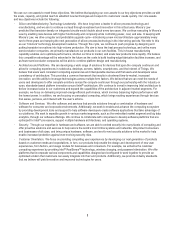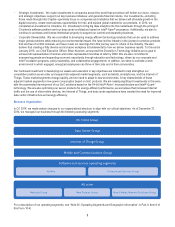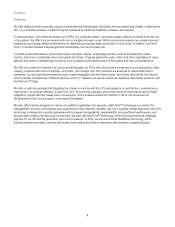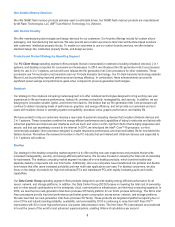Intel 2014 Annual Report Download - page 17
Download and view the complete annual report
Please find page 17 of the 2014 Intel annual report below. You can navigate through the pages in the report by either clicking on the pages listed below, or by using the keyword search tool below to find specific information within the annual report.Our R&D activities range from designing and developing new products and manufacturing processes to researching future
technologies and products. We continue to make significant R&D investments in the development of SoCs to enable growth in
ultra-mobile form factors. In addition, we continue to make significant investments in communications and connectivity for tablets,
smartphones, and other connected devices, including mutlimode LTE modems. Our investment in Cloudera, completed in 2014,
is evidence of our drive to bring big data analytics to the mainstream market through the joining of Cloudera’s software platform
and our data center architecture based on Intel Xeon processors. We also continue to invest in leading-edge foundry platforms
and ecosystem partner development, graphics, high-performance computing, and communication and connectivity.
Our R&D model is based on a global organization that emphasizes a collaborative approach to identifying and developing new
technologies, leading standards initiatives, and influencing regulatory policies to accelerate the adoption of new technologies,
including joint pathfinding conducted between researchers at Intel Labs and our business groups. We centrally manage key
cross-business group product initiatives to align and prioritize our R&D activities across these groups. In addition, we may
augment our R&D activities by investing in companies or entering into agreements with companies that have similar R&D focus
areas, as well as directly purchasing or licensing technology applicable to our R&D initiatives. To drive innovation and gain
efficiencies, we intend to utilize our investments in intellectual property and R&D across our market segments.
Employees
As of December 27, 2014, we had 106,700 employees worldwide, with approximately 51% of those employees located in the U.S.
Sales and Marketing
Customers
We sell our products primarily to OEMs and ODMs. ODMs provide design and manufacturing services to branded and unbranded
private-label resellers. In addition, we sell our products to other manufacturers, including makers of a wide range of industrial and
communications equipment. Our customers also include those who buy PC components and our other products through
distributor, reseller, retail, and OEM channels throughout the world.
Our worldwide reseller sales channel consists of thousands of indirect customers—systems builders that purchase Intel
®
microprocessors and other products from our distributors. We have a program that allows distributors to sell our microprocessors
and other products in small quantities to customers of systems builders; our microprocessors and other products are also
available in direct retail outlets.
In 2014, Hewlett-Packard Company (HP) accounted for 18% of our net revenue (17% in 2013 and 18% in 2012), Dell Inc. (Dell)
accounted for 16% of our net revenue (15% in 2013 and 14% in 2012), and Lenovo Group Limited (Lenovo) accounted for 12% of
our net revenue (12% in 2013 and 11% in 2012). No other customer accounted for more than 10% of our net revenue during such
periods. For information about net revenue and operating income by operating segment, and net revenue from unaffiliated
customers by country, see “Note 26: Operating Segments and Geographic Information” in Part II, Item 8 of this Form 10-K.
Sales Arrangements
Our products are sold through sales offices throughout the world. Sales of our products are frequently made via purchase order
acknowledgments that contain standard terms and conditions covering matters such as pricing, payment terms, and warranties,
as well as indemnities for issues specific to our products, such as patent and copyright indemnities. From time to time, we may
enter into additional agreements with customers covering, for example, changes from our standard terms and conditions, new
product development and marketing, private-label branding, and other matters. Our sales are typically made using electronic and
web-based processes that allow the customer to review inventory availability and track the progress of specific goods ordered.
Pricing on particular products may vary based on volumes ordered and other factors. We also offer discounts, rebates, and other
incentives to customers to increase acceptance of our products and technology.
Our products are typically shipped under terms that transfer title to the customer, even in arrangements for which the recognition
of revenue and related cost of sales is deferred. Our standard terms and conditions of sale typically provide that payment is due
at a later date, generally 30 days after shipment or delivery. We assess credit risk through quantitative and qualitative analysis.
From this analysis, we establish shipping and credit limits, and determine whether we will seek to use one or more credit support
devices, such as obtaining a parent guarantee, standby letter of credit, or credit insurance. Credit losses may still be incurred due
to bankruptcy, fraud, or other failure of the customer to pay. For information about our allowance for doubtful receivables, see
“Schedule II—Valuation and Qualifying Accounts” in Part IV of this Form 10-K.
12
























